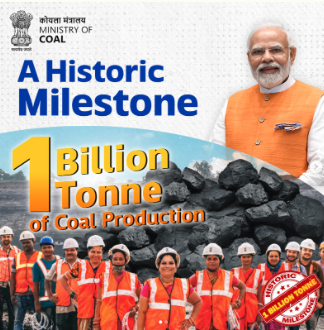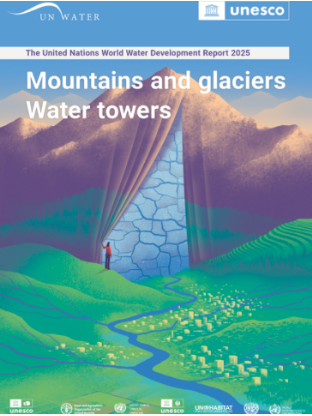Daily Current Affairs | March 22 2025 |
Important Topics from Current Affairs : 1) 1 billion tonnes of coal production 2) SwaYaan Initiative by MeitY 3) UN Water Development Report 2025 4) Section 79 of IT Act
Jumbo IAS
3/22/20255 min read
1) 1 billion tonnes of coal production
India has achieved a momentous milestone in coal production, surpassing one billion tonnes (BT) in the fiscal year 2024-25.
India relies on coal for approximately 55% of its energy mix, and around 74% of the country’s electricity is generated by coal-based power plants.
This underscores the critical importance of coal in powering India’s economy and sustaining energy security.


Types of Coal
Anthracite - The highest rank of coal, hard, brittle, black, and lustrous, with a high percentage of fixed carbon & low volatile matter.
Bituminous - A medium-grade coal with high heating capacity, often called "black coal".
Sub-bituminous - A brownish-black, medium-hard coal, falling between lignite and bituminous in terms of thermal maturity.
Lignite - The lowest rank of coal, often called "brown coal", with the highest moisture content and relatively low energy content.
Coal in India
Gondwana Coal -
Found in peninsular India, these coal deposits were formed around 250–300 million years ago.
States - Jharkhand, Odisha, Chhattisgarh, West Bengal, Madhya Pradesh, and Maharashtra.
These coal deposits are mostly bituminous and sub-bituminous in nature.
Application - Power generation, steel making etc.
Tertiary Coal -
Found in northeastern states J&K and Tamil Nadu, these coal deposits were formed 15–60 million years ago.
States - Assam, Meghalaya, Arunachal, Nagaland, Jammu & Kashmir, Tamil Nadu, Karnataka and Rajasthan.
These deposits are lignite or peat with lower calorific value.
Application - Power generation, domestic heating etc.
Coal Production in India
Commercial coal mining in India began in 1774 at Raniganj Coalfields along the Damodar River.
Coking coal mines nationalised in 1972 under the Coking Coal Mines Act.
Non-coking coal mines nationalised in 1973 under the Coal Mines (Nationalisation) Act.
Coal India Ltd (CIL) because of nationalisation, became the largest producer of coal in India, and still holds that spot.
While the coal sector was nationalised, the Coal Mines (Nationalisation) Act, 1973 was amended in 1993 to facilitate private sector participation in captive coal mining for specific purposes, like power generation.
Other Facts
China is the largest coal producer(Anthracite), followed by India(Bituminous)
Jharkhand has the highest coal production in India, followed by Odisha & Chhattisgarh.
Coking coal, also known as metallurgical coal, is used to produce coke for steelmaking, while non-coking coal, or thermal coal, is primarily used for power generation and other industrial processes.
2) SwaYaan Initiative by MeitY
The Ministry of Electronics and Information Technology (MeitY), in collaboration with the Drone Federation India (DFI), launched the National Innovation Challenge for Drone Application and Research (NIDAR) under the ‘SwaYaan - Capacity Building for Human Resource Development in Unmanned Aircraft Systems’ initiative.


About NIDAR
NIDAR under the project SwaYaan aims to inspire and engage India’s student and research communities to develop collaborative autonomous drones, addressing real-world challenges across two critical domains:
Disaster Management (Scout & Deliver Drones)
Precision Agriculture (Scan & Spray Drones)
The challenge offers a total prize pool of INR 40 Lakhs along with opportunities for startup incubation, cloud credits, software support, and internships.
About SwaYaan Initiative
Approved by MeitY in July, 2022, focuses on capacity building for human resource development in Unmanned Aircraft Systems (UAS), including drones and related technologies.
SwaYaan engages industry partners through innovation challenges and industry meets, reinforcing the link between academic training & real-world application in drone technology.
Aim - Train 42,560 participants, combining both formal and non-formal educational programs to create a skilled workforce in drone technology.
The initiative is implemented through a hub-and-spoke model involving 30 premium institutions like IISc, IITs, IIITs, NITs, CDAC, and NIELIT.
5 Key Themes - Drone Electronics, GNC Algorithms Simulation, Aeromechanics, Drone Applications, and Allied UAS Tech.
3) UN Water Development Report
Soaring temperatures are leading to rapid and largely irreversible changes in the mountain ranges of the world, according to a new UNESCO report.
The ‘The United Nations World Water Development Report 2025 – Mountains and glaciers: Water towers’ was released to mark the first-ever World Day for Glaciers on March 21.
This report was published by UNESCO World Water Assessment Programme (WWAP) on behalf of UN-Water.


Key Highlights
Glacier Melting - Five of the last six years registered the largest losses, with glaciers losing 450 gigatons of mass in 2024 alone.
Permafrost - Acceleration in thawing of permafrost.
Snow Cover - According to the UNESCO report, snow cover in nearly all mountain regions has reduced, especially in spring and summer.
Erratic Snowfall Patterns - In some regions, the elevation at which rainfall transitions to snowfall is shifting upwards due to warming.
Consequences : If this Continues
More Global Warming - Mountain soils with permafrost contain approximately 4.5% of the global soil organic carbon. As the permafrost thaws, this organic carbon is released into the atmosphere, exacerbating climate change. Glacier melting would also reduce Earth’s albedo, further warming the planet.
Water Shortage - Mountains, which cover 33 million sq km of the Earth’s surface, are crucial for sustaining life on the planet. For instance, around 2 billion people downstream depend on mountains for freshwater resources from melting glaciers.
Disasters - Glacier melting and permafrost thaw also increase the risk of glacial lake outburst floods (GLOFs).
Sea Level Rise - According to WGMS(World Glacier Monitoring Service), melted ice of glaciers accounts for 25 to 30% of the currently observed increase in global sea levels.
4) Section 79 of IT Act
Elon Musk-owned X (formerly Twitter) has challenged the government’s use of Section 79(3)(b) of the Information Technology Act, 2000 (IT Act) to moderate and order the removal of content on social media.
The company has argued that govt’s “misuse” of the provision bypasses safeguards available under other provisions of IT Act.


Issue at Hand
Section 66A - It criminalised sending offensive messages through communication devices.
This was struck down by Supreme Court in 2015 under Shreya Singhal Case.
After this, Section 69A of the IT Act became the primary law governing the matter.
This section allows the Centre to block information shared through computer resources, but unlike 66A, it contains safeguards against misuse.
Safeguards - Centre can only block if it deems it “necessary”.
Use of Section 79
The provision is a “safe harbour” measure that exempts an “intermediary” (such as X) from liability for information published on the platform by a “third party”, that is the users.
But Section 79(3)(b) states that the intermediary could be held liable if it does not immediately remove such unlawful information “upon receiving actual knowledge, or on being notified by the appropriate Government or its agency”.
In October 2023, (MeitY) issued a directive to all ministries, state governments, and the police saying that information blocking orders could be issued under Section 79(3)(b).
A year later in October 2024, MeitY launched a portal called “Sahyog” where the aforementioned authorities could issue and upload blocking orders.
Safeguards under Section 69A
For blocking content under Section 69A, the Centre must deem it “necessary”.
This “necessity”, however, is only justifiable under grounds provided in Article 19(2) of the Constitution which “imposes reasonable restrictions” on the freedom of speech.
The Centre must record its reasons in the blocking order so that it can be challenged in court.


